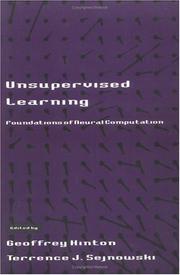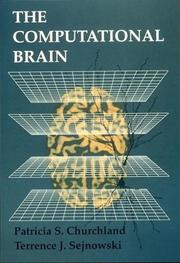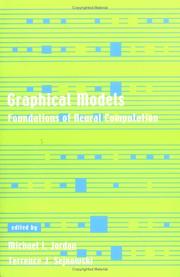| Listing 1 - 9 of 9 |
Sort by
|
Book
ISBN: 908571642X 9789085716426 Year: 2019 Publisher: Utrecht Veen Media
Abstract | Keywords | Export | Availability | Bookmark
 Loading...
Loading...Choose an application
- Reference Manager
- EndNote
- RefWorks (Direct export to RefWorks)
Deel I: Intelligentie herzien - Deel II: Veel manieren om te leren - Deel III: Techonologische en wetenschappelijke invloed

ISBN: 0262288036 0585358958 9780262288033 9780585358956 9780262338554 0262338556 9780262581684 026258168X Year: 1999 Publisher: Cambridge, Mass. MIT Press
Abstract | Keywords | Export | Availability | Bookmark
 Loading...
Loading...Choose an application
- Reference Manager
- EndNote
- RefWorks (Direct export to RefWorks)
Learning --- Neural networks (Computer science) --- Neural computers --- Neuroscience --- Human Anatomy & Physiology --- Health & Biological Sciences --- Physiological aspects --- Computer simulation --- Neural net computers --- Neural network computers --- Neurocomputers --- Learning process --- Artificial neural networks --- Nets, Neural (Computer science) --- Networks, Neural (Computer science) --- Neural nets (Computer science) --- Neural networks. --- Comprehension --- Education --- Neuropsychology --- Physiological aspects. --- Computer simulation. --- Neural computers. --- Electronic digital computers --- Natural computation --- Artificial intelligence --- Cognitive psychology --- Artificial intelligence. Robotics. Simulation. Graphics --- Neural networks (Computer science). --- Apprentissage --- Réseaux neuronaux (Informatique) --- Ordinateurs neuronaux --- Aspect physiologique

ISBN: 0262531208 0262031884 0262270293 0585038759 9780262270298 9780585038759 9780262031882 9780262339650 026233965X 9780262531207 9780262533393 0262533391 0262339668 Year: 2017 Publisher: Cambridge, MA
Abstract | Keywords | Export | Availability | Bookmark
 Loading...
Loading...Choose an application
- Reference Manager
- EndNote
- RefWorks (Direct export to RefWorks)
An anniversary edition of the classic work that influenced a generation of neuroscientists and cognitive neuroscientists.Before The Computational Brain was published in 1992, conceptual frameworks for brain function were based on the behavior of single neurons, applied globally. In The Computational Brain, Patricia Churchland and Terrence Sejnowski developed a different conceptual framework, based on large populations of neurons. They did this by showing that patterns of activities among the units in trained artificial neural network models had properties that resembled those recorded from populations of neurons recorded one at a time. It is one of the first books to bring together computational concepts and behavioral data within a neurobiological framework. Aimed at a broad audience of neuroscientists, computer scientists, cognitive scientists, and philosophers, The Computational Brain is written for both expert and novice. This anniversary edition offers a new preface by the authors that puts the book in the context of current research.This approach influenced a generation of researchers. Even today, when neuroscientists can routinely record from hundreds of neurons using optics rather than electricity, and the 2013 White House BRAIN initiative heralded a new era in innovative neurotechnologies, the main message of The Computational Brain is still relevant.
#TELE:MI2 --- Circuitry [Neural ] --- Circuits [Neural ] --- Nerveux [Réseau ] --- Net [Zenuw] --- Neurale netwerken (Informatica) --- Réseau nerveux --- Réseaux neuraux (Informatique) --- Zenuwnet --- Models, Neurological --- Models of computation: automata; bounded action devices; computability theory; relations among models; self-modifying machines; unbounded-action devices--See also {681.3*F41} --- Computer Simulation. --- Models, Neurological. --- 681.3*F11 Models of computation: automata; bounded action devices; computability theory; relations among models; self-modifying machines; unbounded-action devices--See also {681.3*F41} --- Artificial intelligence. Robotics. Simulation. Graphics --- Computer architecture. Operating systems --- Brain --- Neural networks (Neurobiology) --- 681.3*F11 --- Biological neural networks --- Nets, Neural (Neurobiology) --- Networks, Neural (Neurobiology) --- Neural nets (Neurobiology) --- Cognitive neuroscience --- Neurobiology --- Neural circuitry --- Cerebrum --- Mind --- Central nervous system --- Head --- Computer simulation --- Computer Simulation --- Neurosciences --- physiology --- methods --- Neural networks (Neurobiology). --- Computer simulation. --- physiology. --- methods. --- Brain - Computer simulation. --- Neural networks (Computer science) --- Neural circuitry. --- Physiology. --- Methods. --- Brain - physiology --- Neurosciences - methods --- Brain - Computer simulation --- NEUROSCIENCE/General --- COGNITIVE SCIENCES/General
Book
ISBN: 1558601236 9781558601239 Year: 1990 Publisher: Los Altos Kaufmann
Abstract | Keywords | Export | Availability | Bookmark
 Loading...
Loading...Choose an application
- Reference Manager
- EndNote
- RefWorks (Direct export to RefWorks)
Artificial intelligence --- Machine Learning --- Machine learning --- 681.3*I26 --- Learning, Machine --- Machine theory --- AI (Artificial intelligence) --- Artificial thinking --- Electronic brains --- Intellectronics --- Intelligence, Artificial --- Intelligent machines --- Machine intelligence --- Thinking, Artificial --- Bionics --- Cognitive science --- Digital computer simulation --- Electronic data processing --- Logic machines --- Self-organizing systems --- Simulation methods --- Fifth generation computers --- Neural computers --- Learning: analogies; concept learning; induction; knowledge acquisition; language acquisition; parameter learning (Artificial intelligence)--See also {681.3*K32} --- 681.3*I26 Learning: analogies; concept learning; induction; knowledge acquisition; language acquisition; parameter learning (Artificial intelligence)--See also {681.3*K32} --- Artificial intelligence.
Book
ISBN: 9780262356145 0262356147 9780262043243 0262043246 Year: 2019 Publisher: Cambridge : MIT Press,
Abstract | Keywords | Export | Availability | Bookmark
 Loading...
Loading...Choose an application
- Reference Manager
- EndNote
- RefWorks (Direct export to RefWorks)
Experts review the latest research on the neocortex and consider potential directions for future research.Over the past decade, technological advances have dramatically increased information on the structural and functional organization of the brain, especially the cerebral cortex. This explosion of data has radically expanded our ability to characterize neural circuits and intervene at increasingly higher resolutions, but it is unclear how this has informed our understanding of underlying mechanisms and processes.In search of a conceptual framework to guide future research, leading researchers address in this volume the evolution and ontogenetic development of cortical structures, the cortical connectome, and functional properties of neuronal circuits and populations. They explore what constitutes uniquely human mental capacities and whether neural solutions and computations can be shared across species or repurposed for potentially uniquely human capacities.Contributors Danielle S. Bassett, Randy M. Bruno, Elizabeth A. Buffalo, Michael E. Coulter, Hermann Cuntz, Stanislas Dehaene, James J. DiCarlo, Pascal Fries, Karl J. Friston, Asif A. Ghazanfar, Anne-Lise Giraud, Joshua I. Gold, Scott T. Grafton, Jennifer M. Groh, Elizabeth A. Grove, Saskia Haegens, Kenneth D. Harris, Kristen M. Harris, Nicholas G. Hatsopoulos, Tarik F. Haydar, Takao K. Hensch, Wieland B. Huttner, Matthias Kaschube, Gilles Laurent, David A. Leopold, Johannes Leugering, Belen Lorente-Galdos, Jason N. MacLean, David A. McCormick, Lucia Melloni, Anish Mitra, Zoltn Molnr, Sydney K. Muchnik, Pascal Nieters, Marcel Oberlaender, Bijan Pesaran, Christopher I. Petkov, Gordon Pipa, David Poeppel, Marcus E. Raichle, Pasko Rakic, John H. Reynolds, Ryan V. Raut, John L. Rubenstein, Andrew B. Schwartz, Terrence J. Sejnowski, Nenad Sestan, Debra L. Silver, Wolf Singer, Peter L. Strick, Michael P. Stryker, Mriganka Sur, Mary Elizabeth Sutherland, Maria Antonietta Tosches, William A. Tyler, Martin Vinck, Christopher A. Walsh, Perry Zurn
Neocortex. --- NEUROSCIENCE/General --- Homogenetic cortex --- Isocortex --- Laminated cortex --- Neopallium --- Nonolfactory cortex --- Cerebral cortex
Book
Year: 2001 Publisher: Cambridge, Massachusetts : [Piscataqay, New Jersey] : MIT Press, IEEE Xplore,
Abstract | Keywords | Export | Availability | Bookmark
 Loading...
Loading...Choose an application
- Reference Manager
- EndNote
- RefWorks (Direct export to RefWorks)
Graphical models use graphs to represent and manipulate joint probability distributions. They have their roots in artificial intelligence, statistics, and neural networks. The clean mathematical formalism of the graphical models framework makes it possible to understand a wide variety of network-based approaches to computation, and in particular to understand many neural network algorithms and architectures as instances of a broader probabilistic methodology. It also makes it possible to identify novel features of neural network algorithms and architectures and to extend them to more general graphical models.This book exemplifies the interplay between the general formal framework of graphical models and the exploration of new algorithms and architectures. The selections range from foundational papers of historical importance to results at the cutting edge of research.Contributors H. Attias, C. M. Bishop, B. J. Frey, Z. Ghahramani, D. Heckerman, G. E. Hinton, R. Hofmann, R. A. Jacobs, Michael I. Jordan, H. J. Kappen, A. Krogh, R. Neal, S. K. Riis, F. B. Rodr
Periodical
Year: 1992 Publisher: Cambridge, Mass. London MIT Press
Abstract | Keywords | Export | Availability | Bookmark
 Loading...
Loading...Choose an application
- Reference Manager
- EndNote
- RefWorks (Direct export to RefWorks)
Book
ISBN: 9780262038034 026203803X 9780262346825 0262346826 Year: 2018 Publisher: Cambridge, Massachusetts [Piscataqay, New Jersey] The MIT Press IEEE Xplore
Abstract | Keywords | Export | Availability | Bookmark
 Loading...
Loading...Choose an application
- Reference Manager
- EndNote
- RefWorks (Direct export to RefWorks)
"How deep learning-from Google Translate to driverless cars to personal cognitive assistants-is changing our lives and transforming every sector of the economy. The deep learning revolution has brought us driverless cars, the greatly improved Google Translate, fluent conversations with Siri and Alexa, and enormous profits from automated trading on the New York Stock Exchange. Deep learning networks can play poker better than professional poker players and defeat a world champion at Go. In this book, Terry Sejnowski explains how deep learning went from being an arcane academic field to a disruptive technology in the information economy. Sejnowski played an important role in the founding of deep learning, as one of a small group of researchers in the 1980s who challenged the prevailing logic-and-symbol based version of AI. The new version of AI Sejnowski and others developed, which became deep learning, is fueled instead by data. Deep networks learn from data in the same way that babies experience the world, starting with fresh eyes and gradually acquiring the skills needed to navigate novel environments. Learning algorithms extract information from raw data; information can be used to create knowledge; knowledge underlies understanding; understanding leads to wisdom. Someday a driverless car will know the road better than you do and drive with more skill; a deep learning network will diagnose your illness; a personal cognitive assistant will augment your puny human brain. It took nature many millions of years to evolve human intelligence; AI is on a trajectory measured in decades. Sejnowski prepares us for a deep learning future." [Publisher]
Artificial intelligence. Robotics. Simulation. Graphics --- Philosophy and psychology of culture --- Machine Learning --- Big data --- Artificial intelligence --- Social aspects --- Machine learning. --- Big data. --- Apprentissage automatique --- Données massives --- Intelligence artificielle --- Social aspects. --- Cultuurfilosofie. Cultuurpsychologie --- Artificiële intelligentie. Robotica. Simulatie. Graphics --- Apprentissage automatique. --- Données massives. --- Intelligence artificielle. --- Artificial intelligence - Social aspects --- Données massives.

ISBN: 9780262291200 9780262600422 0262600420 Year: 2001 Publisher: Cambridge, Massachusetts [Piscataqay, New Jersey] MIT Press IEEE Xplore
Abstract | Keywords | Export | Availability | Bookmark
 Loading...
Loading...Choose an application
- Reference Manager
- EndNote
- RefWorks (Direct export to RefWorks)
| Listing 1 - 9 of 9 |
Sort by
|

 Search
Search Feedback
Feedback About UniCat
About UniCat  Help
Help News
News